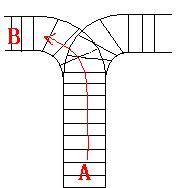Train Problem I
Time Limit: 2000/1000 MS (Java/Others) Memory Limit: 65536/32768 K (Java/Others)
Total Submission(s): 30245 Accepted Submission(s):
11434
Problem Description
As the new term comes, the Ignatius Train Station is
very busy nowadays. A lot of student want to get back to school by train(because
the trains in the Ignatius Train Station is the fastest all over the world ^v^).
But here comes a problem, there is only one railway where all the trains stop.
So all the trains come in from one side and get out from the other side. For
this problem, if train A gets into the railway first, and then train B gets into
the railway before train A leaves, train A can't leave until train B leaves. The
pictures below figure out the problem. Now the problem for you is, there are at
most 9 trains in the station, all the trains has an ID(numbered from 1 to n),
the trains get into the railway in an order O1, your task is to determine
whether the trains can get out in an order O2.






Input
The input contains several test cases. Each test case
consists of an integer, the number of trains, and two strings, the order of the
trains come in:O1, and the order of the trains leave:O2. The input is terminated
by the end of file. More details in the Sample Input.
Output
The output contains a string "No." if you can't
exchange O2 to O1, or you should output a line contains "Yes.", and then output
your way in exchanging the order(you should output "in" for a train getting into
the railway, and "out" for a train getting out of the railway). Print a line
contains "FINISH" after each test case. More details in the Sample
Output.
Sample Input
3 123 321
3 123 312
Sample Output
Yes. in in in out out out FINISH No. FINISH
Hint
HintFor the first Sample Input, we let train 1 get in, then train 2 and train 3. So now train 3 is at the top of the railway, so train 3 can leave first, then train 2 and train 1. In the second Sample input, we should let train 3 leave first, so we have to let train 1 get in, then train 2 and train 3. Now we can let train 3 leave. But after that we can't let train 1 leave before train 2, because train 2 is at the top of the railway at the moment. So we output "No.".
题目大概意思:有N辆火车,以序列1方式进站,判断是否能以序列2方式出栈。进站不一定是一次性进入,也就是说中途可以出站。
1 /*模拟方法:把序列一入栈,并与序列二的进行比较,判断是否应该后移指针*/ 2 #include<iostream> 3 #include<cstdio> 4 using namespace std; 5 #include<cstring> 6 #include<stack> 7 #define N 10001 8 char str1[N],str2[N]; 9 int n; 10 int k=0,result[N];//储存结果 11 stack<char>sta; 12 int main() 13 { 14 while(scanf("%d%s%s",&n,str1,str2)==3) 15 { 16 int i=0,j=0; 17 k=0;/*别忘了k的初始化*/ 18 while(!sta.empty()) sta.pop(); 19 sta.push(str1[0]);//先把第一个入栈 20 result[++k]=1; 21 while(i<n&&j<n) 22 { 23 // char mm=sta.top();/*不要这样写,如果sta是空,会报错*/ 24 if(!sta.empty()&&sta.top()==str2[j])/*注意要把取栈顶放在后面,语句&&前面的不符合,后面的就不执行了,不会出错*/ 25 { 26 sta.pop(); 27 result[++k]=0;/*出栈即为0*/ 28 j++; 29 } 30 else 31 { 32 ++i;/*不要用i=1,i++放到后面,因为我们判断i==n是结束条件,放在后面i==n时,实际上才到了n-1*/ 33 sta.push(str1[i]); 34 result[++k]=1;/*入栈即为1*/ 35 // 36 } 37 } 38 if(i==n)/*如果正常匹配成功的话,最后一步是i==n-1,j==n,如果匹配失败,最后一步是i==n-1后再++*/ 39 printf("No. "); 40 else{ 41 printf("Yes. "); 42 for(int i=1;i<=k;++i) 43 if(result[i]) 44 printf("in "); 45 else printf("out "); 46 47 } 48 printf("FINISH "); 49 memset(result,0,sizeof(result)); 50 memset(str1,0,sizeof(str1)); 51 memset(str2,0,sizeof(str2)); 52 53 } 54 return 0; 55 }